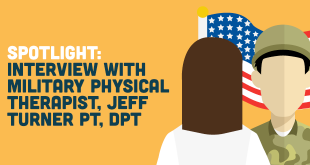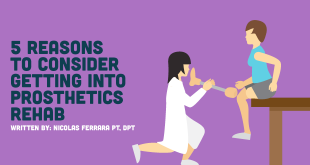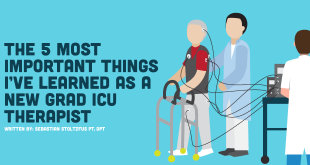This is the second time I’m writing this article. The first time I sat down to write about careers to pursue following graduation (and would have actually submitted the final draft by the deadline) I took a safer approach and wrote about how there are lots of different paths to take, and what mattered most was your courage to pick that path. Shortly after I finished writing that version of the article, I met up with Jen Esquer, a friend and new grad physical therapist in California that I met through the power of social media. She inadvertently, and unknowingly, convinced me to scrap that article and rewrite it completely…and keep it real. So here goes nothing.
The shortcomings of PT school
PT school prepares you to be safe. It caters to the NPTE boards, and often times, more modern techniques that have yet to be substantiated by loads of research, get little (if any) attention. In that same vein, if you are fortunate enough to have a business class or even simply someone who comes in to share their career journey, it’s often limited to traditional experiences and standard post-graduation paths. For those of you who have yet to apply to PT school, it should be noted that there are schools with progressive programs such as Emory University, that offer dual degrees, combining a traditional DPT with business classes and/or an MBA. However, the majority of new grads in traditional programs are presented with horror stories that scare them from ever opening their own business because of the forecasted initial years of slavery and impending debt. Students are given the typical options to work in a hospital, high-volume clinic, or continue to make little to no money and go into a residency. While each path has its benefits and is far from a death sentence, there are other options.
After talking to numerous students, I’ve come to realize that one of the biggest shortcomings of physical therapy school is that it fails to instill confidence in its graduates. Chiropractors come out of school ready to start their own practice; meanwhile, physical therapists graduate and immediately look for more school, be it in the form of a mentorship or residency, or some sort of other closely-supervised position. While I do appreciate this calculated “see the path before you step” approach, I fear that some students may take it too far and pass up opportunities, or simply never even attempt to set out down a certain road out of fear.
PTs have endless potential careers
When I decided to go to PT school, instead of medical school, I did so for a few reasons. One reason was the career flexibility afforded by physical therapy. I saw what Gray Cook and Sue Falsone were doing and thought to myself, “Hey, maybe I can do that, too.” I realized then that becoming a physical therapist didn’t mean I had to work in a clinic, wear a white jacket, and take orders from a doctor. We are the movement experts, and as such, our career potential is endless.
Now, this may be a bit off topic, but in my opinion, our current healthcare model is broken. How we, as physical therapists, treat patients is dictated by insurance companies that consider “functional” to mean your pain isn’t 10/10. Additionally, depending on the state, doctors serve as gatekeepers. This is despite the fact that they have no idea what we actually do, and that ultrasound is not some magical machine.
So what is a new grad to do? Based on what I’ve seen on social media, and what I’ve encountered teaching and connecting with students across the country, students are already taking it on themselves to learn more than just what their DPT programs are giving them. They want to explore different careers! Heck, if you’re reading this article then you’re one of those very students. For this new generation of motivated individuals to simply fall in line with the traditional model, seeing 20 patients a day only to burn out in a few years, or simply going to work in a hospital because that’s what they think they’re “supposed” to do, would be a HUGE disservice. Don’t get me wrong, if your passion is to work in a SNF, or do rotations at a hospital, or work in a high-volume clinic, or do a residency, by all means, jump in headfirst and follow your dreams; I wholeheartedly support you. But if that doesn’t appeal to you, if that doesn’t sit well with you, I’m here to tell you that there are other options.
The NGPT website has a whole host of resources devoted to helping you develop your own brand, enhance your skill set, and market yourself. While I think the current model of PT school lends itself to new grads finding a mentor of sorts following grad school, you shouldn’t be afraid to develop and promote yourself in the process. It’s not humble bragging. Of course, be safe in your treatments and don’t sell yourself as more than you are, but by all means go and make connections, take courses, design your own website, and let your presence be known.
Be fearless in the pursuit of what sets your soul on fire.
The impossible is actually very possible
I have created a hybrid model where I treat, I teach, and also coach and correct movement. I have sessions where I don’t even touch the person because they’re not in pain, and have sought my services to either prevent injury or improve movement. I’ve done remote sessions via Skype where the goal was to assess movement patterns and offer suggestions. I’ve done one-on-one sessions where I’ve served as more of a tutor, simply explaining my method of treatment to the interested party. I travel the country and teach courses for RockTape. I give private courses. I workout for 2 hours every day, I set my own schedule, I go on vacation when I want. To put it simply, I do what makes me happy.
I, personally, was not ready to jump into such a position immediately out of PT school, but I do wish that someone had at least told me it was a legitimate possibility for my future. While I saw the likes of Gray Cook doing it, I kind of thought of it like a kid who was playing basketball in the schoolyard and watching the pros play on TV; it seemed like a pipe dream. Let me be that person for you. Let me tell you that it is possible. You can be a hybrid strength coach. You can be a consultant. You can be a traveling PT. You can start your own company. You don’t have to take insurance! You can create whatever model you want, so long as you’re willing to work for it.
So what now?
As for how long to wait to make your career move or when the time will be right, start thinking like a physical therapist and stop looking for absolute answers. Work with a mentor, reach out to people who are doing what you’re doing, ask questions, but remember that your journey is unique to you. If you’ve been following my posts on New Grad Physical Therapy then you’ll notice I always err on the side of broad statements and never provide a step-by-step template when it comes to offering advice. Why? Because that’s not how physical therapists operate. As Dan John would say “If someone prescribes a one-size fits all approach I can guarantee one thing: IT’S WRONG!” I use these articles as a way to provide guidance that I not only wish I had received as a new grad, but guidance that can also be molded by each reader to fit their individual experience. I beg you, please stop looking for cookie-cutter approaches that you can then follow step-by-step.
At the end of the day, remember this: your first job will not be your last job. That in mind, try not to approach your first job as a life or death situation. If it’s a great fit, you can stay. If it isn’t, you can leave. To quote J.P. Morgan, “Go as far as you can see; when you get there, you will see farther.” The most important part is simply having the courage to take the first step.
For More Career Information Check Out These Great Resources
Guide to Physical Therapy Settings – Every physical therapy setting with pros, cons, salary, and more
8 Non-Clinical Jobs for Physical Therapists – Non-clinical jobs for physical therapists
Ultimate Guide to Physical Therapy Certifications – Every certification for physical therapists including pros, cons, costs, recertification and more!
 NewGradPhysicalTherapy.com The Largest Online Resource For New Grad Physical Therapists
NewGradPhysicalTherapy.com The Largest Online Resource For New Grad Physical Therapists








This is easily my favorite article on tis website. The mindset that this article embraces is something that is almost frowned upon in a DPT program. I have wanted to start my own practice with a hyrbid approach since before school started. Exciting to know it is possible.
CJ! Thanks so much for the kind words. Glad to hear that the article resonated with you. Completely agree that this mindset is something that PT school doesn’t really do such a great job promoting. If that hybrid model is what you’re passionate about, then you keep your eye on the prize and don’t stop til you get there! Best of luck with your journey, and thanks again for reaching out! Don’t be a stranger.
PS – what box are you at? asking in reference to your profile pic.
I was at Crossfit Soul Miami but I have relocated to orlando to finish clinicals. It was a Sad day when I left. I had this “hybrid” model rolling with helping with injury (treating), and coaching in all realms of fitness and rehab. But new place and time to rebuild, or suppose truly start developing my business model. I was wondering if i could ask you a few question? Please let me know.
New place, new opportunities! Miami has always been a favorite of mine. CrossFit Armed is my usual drop in spot. Email me at and hit me up with any questions you may have! Heck, maybe I’ll turn it into my next article!
Thanks for the feedback, CJ! Shante is an excellent resource for what you’re hoping to do with your career. Glad you can connect with her at NGPT 🙂
While I have been a physical therapist for some years now, I have learned a lot of where I want my career to go. This article really hit home in terms of falling into the mold after PT school. I worked in the hospital for a couple years after PT school but I knew this was not the setting for me. The last four years I have been at a couple of outpatient clinics and while I do love this setting, the limitations set by insurance and by the clinic (treating a patient for 30-45 minutes) have started my thinking about where I want to go from here.
While I was in grad school, I did have the dream of wanting to open up my own practice, but as you pointed in your article how PT school does not really prepare you for it, I thought that dream would be too far fetched. Then I thought well maybe I should do a residency just because that is what our professors recommended. Everything that I thought about clearly showed how PT school and steers students into the “mold” of what to do post PT school.
As I contemplate more and more about my career and life, I definitely keep thinking that there is more to life than falling into that “mold” of going to school, then going to work and then retiring. There is so much more life out there to be lived other than working a typical 8 hour day 5 days a week. So I am so thankful to read this insightful article, which has confirmed my aspirations to try travelling PT and even a hybrid model as you have taken. I have learned what I do not want to do and now I want to be able to do what I want to do. I want to travel, teach, take courses, work when I want to work and make myself happy!
Thanks for the kind words Jenn, and we are glad the article was helpful! There are no limits to what you can do as a PT :). As you said, “learning what you do not want to do” is an important part of the journey – In my opinion, it is the most important part of the journey because that is the inherent definition of growth. Keep trying new things and I know you will be a rockstar at them! We are always here for guidance along the way. If you ever have questions or want to chat, shoot us a comment or message.
Jenn! What a fanstastically brilliant response! I absolutely LOVE hearing from passionate people like yourself, and am so excited that you’ve decided to take the leap and follow your happiness. I couldn’t agree more with everything you said, particularly your last paragraph; “There is so much more life out there to be lived other than working a typical 8 hour day 5 days a week.” Preach it, sister! There absolutely is, and I have no doubt that you will find your way and never look back. Thanks so much for reaching out and leaving such a personal, and ah-mazing response. As Brett said, we’re always here to chat, so don’t be a stranger. Best of luck with your journey.
This post was right on time for me. I am a recent DPT grad that is currently searching for employment and studying to take my boards in July. I have so many classmates that have found their passion and know exactly what setting and population they want to work in. Me on the other hand, has always had several passions and want to treat a variety of people. I know I would not want to work in the same place for 40 hrs a week. In undergrad, I was very happy exploring several passions by working 4 jobs as well as volunteering. I am also a previous D1 athlete and I want to get my CSCS, but at the same time I don’t only want to treat athletes. I have a love for women’s health and oncology patients. I know those two things are opposite but it’s what I like. I hope to one day be a strength and conditioning coach as well as treating women’s health patients and maybe one day be an adjunct professor. I like variety! Thank you for confirming that it’s ok to do several things in our profession.
Lee! Take that energy and run with it! It’s so great hearing from new grads who realize that the sky is the limit. And while you may think that treating athletes and having a fondness for women’s health and oncology are polar opposites, I think once you dive into those worlds you’ll see that they’re not all that unrelated. A good clinician treats the person, not the tissues, and all those systems, musculoskeletal, urogenital, gastrointestinal, endocrine, circulatory, lymphatic…they all work together. The knowledge you gain from treating each of those different populations will allow you to better synthesize a more well-rounded approach and will ultimately lead to better outcomes. Can’t wait to see what the future holds in store for you. Good luck and we’re always here if you need us!
Hello,
This is my first time posting and I just want to say that I am excited to interact with you all at NewgradPT, because you have provided such great insight for me and my colleagues thus far. This article, like so many others, struck a cord for me and I am trying to seek the proper channels to problem solve for my future professional endeavors. I currently have an opportunity to grow within a performance company that already has a fitness facility and potential clientele. Do you know of any resources that provides guidance to starting a PT practice inside of a fitness facility and what kind of advantages and disadvantages that kind of setting would cause? I would also love to contact any people you all here at NewGradPT know of that follow a similar model to this. This seems like a once in a lifetime kind of opportunity and I want to do my best to approach it in the best way.
Thank you!
Hey there Anil!
First off, please accept my apologies for the delayed response. I travel quite extensively for work and somehow missed your comment. Congrats on the job opportunity. It does indeed sound exciting. Off the top of my head I can’t think of any specific resources, but you might considering reaching out to to Steve Sudell. He’s a PT who own Prehab2Perform, which operates out of Crossfit Paradiso, in Venice, CA. His email is . I can’t say with any kind of certainty how quickly he will get back to you, but his model most closely parallels what you’ve described, so it’s definitely worth reaching out to hm. While I have operated out of a CrossFit box, I was also treating in 2 other locations, and teaching. Somewhat different circumstances which allowed me to use a different model than what yours would likely look be. Additionally, make sure you check out the resources on NGPT regarding starting your own cash clinic. Again, sorry for the delayed response. Best of luck with this awesome endeavor!